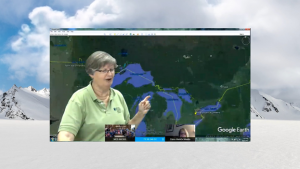Module 1: The Global and the Local in Indigenous Knowledge
Entry 3: Connected North
Much of the rhetoric around the ‘Digital Divide’ tends to focus on physical access in rural areas, particularly those in North America. However, a similar issue afflicts remote and Northern Indigenous communities across Canada as well. Connected North employs Telepresence video technology to create immersive and engaging learning experiences for Indigenous learners; First Nations, Inuit and Métis industry experts, community leaders, and role models are brought in to enhance learning outcomes (Connected North, n.d.). The initiative fosters a sense of empowerment, relationship-building, and ‘big picture’ thinking to motivate and inspire Indigenous learners. A diverse series of service providers and program supporters can provide the infrastructure, technology, and overall ‘know-how’ to facilitate this process.
In my view, once the issue of reliable physical access to the Internet is ameliorated, then curriculum matters can be properly reconciled with technology more generally and provide learners with experiences typically reserved for more ‘well-connected’ schools. The ‘Digital Divide’ can only begin to be adequately addressed when both physical access and curriculum/technology are resolved, and this is especially true for Indigenous communities. If the physical access matter is resolved but the technology is used to propagate ‘Western’ pedagogy exclusively, then the ‘Digital Divide’ would not truly be closed.

Figure 1. Telepresence Video Footage. (n.d.). The Connected North Story. Connected North. Retrieved May 26, 2021 from https://www.connectednorth.org/en/. Screenshot by author.
Connected North. (n.d.). Connected North. Retrieved May 26, 2021, from https://www.connectednorth.org/en/